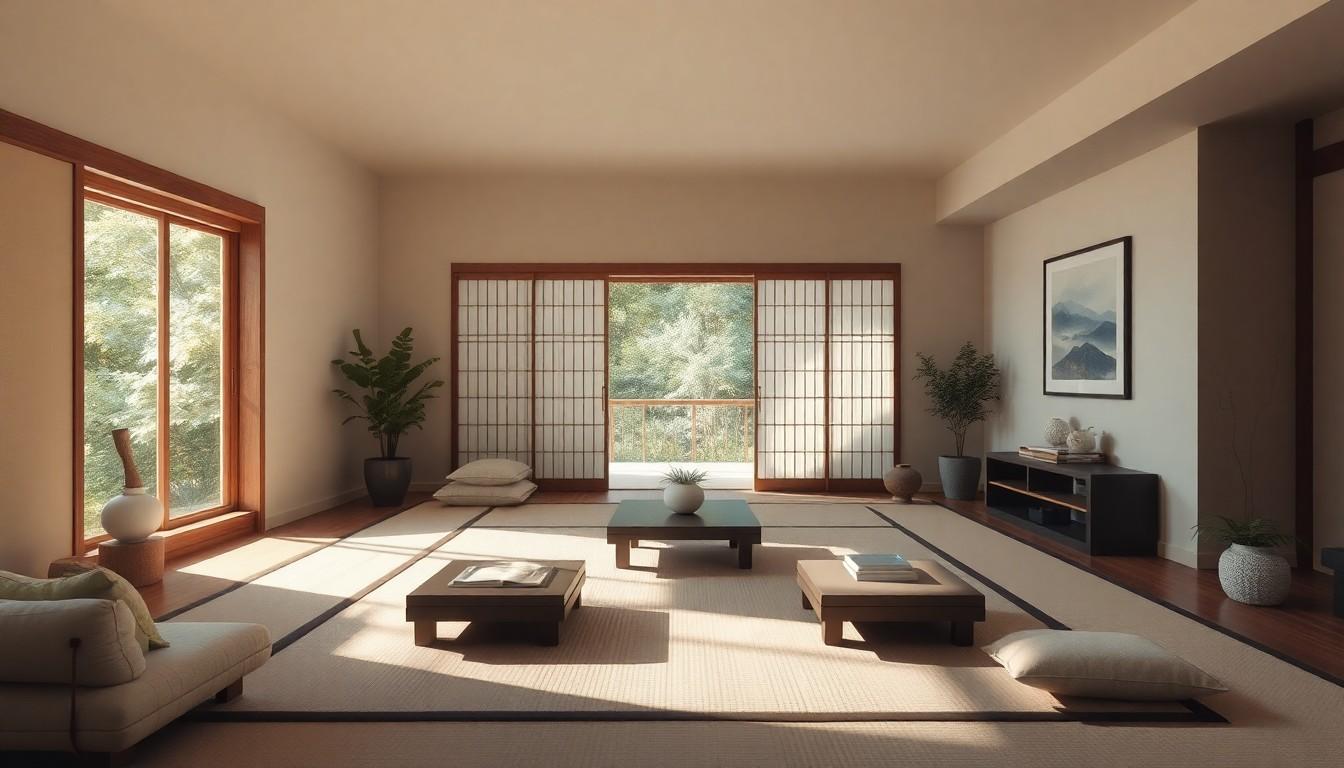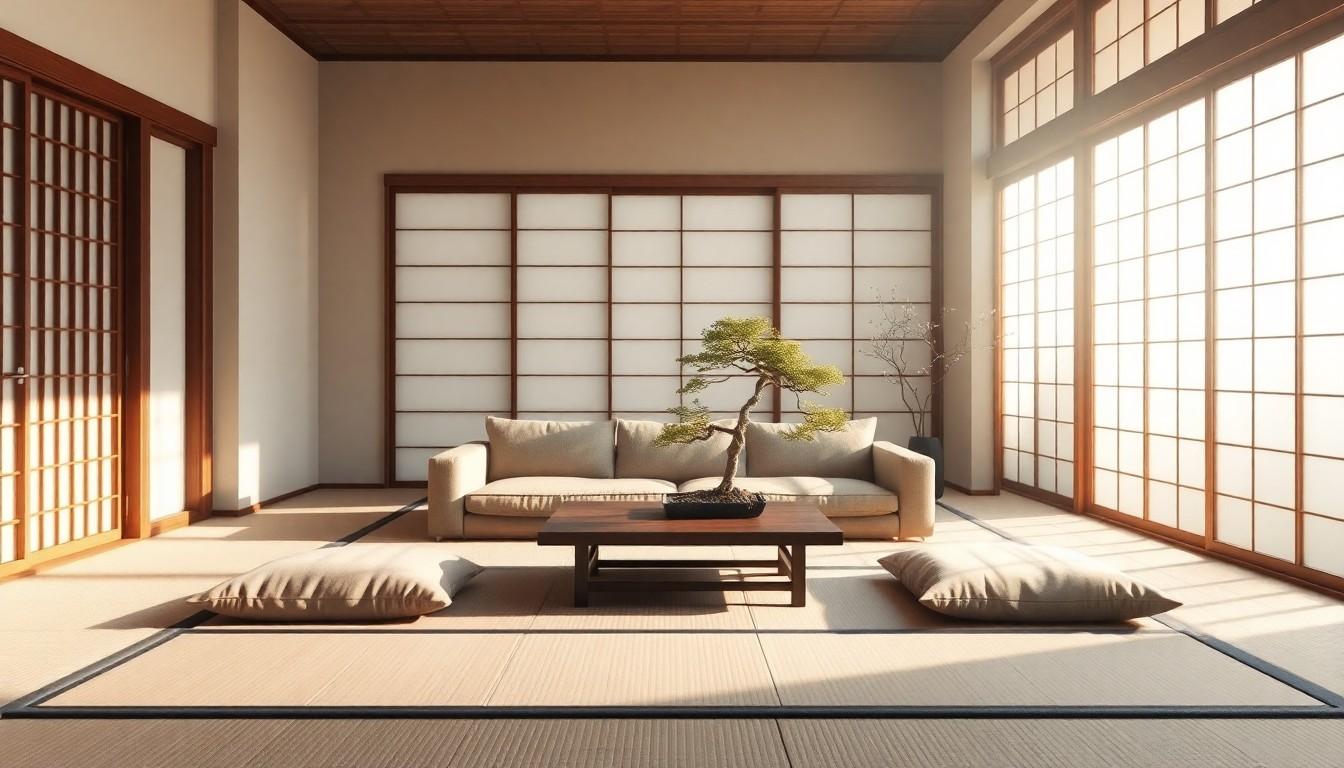Step into a Japanese living room, and you might just feel like you’ve entered a serene zen garden—minus the rakes and gravel. With their minimalist design and harmonious aesthetics, these spaces offer a perfect blend of beauty and functionality. Imagine sipping tea while surrounded by tatami mats, shoji screens, and the gentle glow of paper lanterns. It’s like living in a work of art, but without the risk of being critiqued by a pretentious art critic.
Japanese living rooms invite tranquility and simplicity, making them the ultimate sanctuary for relaxation. Whether it’s the clever use of space or the thoughtful incorporation of nature, each element serves a purpose. So, if you’re ready to transform your chaotic living space into a peaceful retreat, dive into the world of Japanese design. Who knew that less really could be more?
Table of Contents
ToggleOverview of Japanese Living Rooms
Japanese living rooms epitomize tranquility and simplicity. These spaces rely on minimalism, creating an inviting atmosphere for relaxation and reflection.
Key Characteristics
Minimal furniture dominates Japanese living rooms. Low-profile couches and floor cushions encourage comfort while maintaining an open feel. Tatami mats, made from rice straw, serve as flooring, adding warmth and texture. Natural materials, such as wood and bamboo, integrate seamlessly into the décor. Shoji screens provide privacy while allowing light to filter through, enhancing the serene ambiance. Paper lanterns or simple pendant lights create a soft glow, emphasizing relaxation in the room.
Cultural Significance
Cultural values shape the design of Japanese living rooms. Influenced by Zen Buddhism, these spaces prioritize harmony and balance. They promote a connection to nature, often incorporating plants or garden views. Shared spaces foster family interactions, reinforcing community bonds. Traditional tea ceremonies emphasize hospitality within these environments, highlighting the importance of mindfulness and appreciation for simplicity.
Design Elements

Japanese living rooms embody tranquility and simplicity through thoughtful design elements. The focus on natural aesthetics creates a serene space for relaxation.
Color Schemes
Neutral tones dominate the color palettes in Japanese living rooms. Typically, shades of beige, cream, and soft greens evoke a calming environment. Accent colors often include muted earth tones, enhancing a connection to nature. These choices promote harmony and balance, crucial aspects of Japanese design. Light colors allow natural light to penetrate, which fosters an airy atmosphere. Darker tones also occur, especially in traditional settings, offering depth and warmth to the space.
Furniture Choices
Low-profile furniture is a hallmark of Japanese living room design. Couches often feature clean lines, providing a sense of spaciousness. Floor cushions serve as versatile seating options, encouraging relaxation. Traditional elements such as tatami mats create an inviting foundation. Materials like bamboo, rattan, and natural wood contribute to the organic aesthetic. Minimalist furniture arrangements promote openness, facilitating easy movement. A few carefully selected pieces enhance function without overwhelming the space, fostering a peaceful retreat.
Space Optimization
Japanese living rooms exemplify space optimization through design strategies that embrace simplicity and functionality.
Minimalist Approach
Emphasizing simplicity, the minimalist approach focuses on essential elements. Tatami mats lay down a foundation for comfort, while low-profile furniture keeps the space open. Each piece serves a purpose, limiting clutter and distractions. Shoji screens create flexible boundaries, enhancing room flow. Natural light filters through, contributing to a serene atmosphere. A neutral color palette, featuring beige and soft greens, reinforces calmness and connection to nature. Combining these design choices creates a tranquil retreat, inviting relaxation and mindfulness.
Multi-Functional Furniture
Multi-functional furniture plays a vital role in Japanese living room design. Low couches transform into sleeping areas when needed, maximizing space utility. Floor cushions serve as versatile seating options, easily moved for gatherings or meditation. Storage solutions hidden within furniture maintain the clean aesthetic while providing organization. Tables often double as platforms for tea ceremonies or meals, enhancing communal interactions. This adaptability caters to various activities, ensuring the space remains practical without sacrificing beauty. Such design reflects the seamless integration of functionality and tranquility.
Traditional vs. Modern Styles
Japanese living rooms reflect a beautiful contrast between traditional and modern styles, showcasing unique elements that define each approach.
Tatami and Futons
Tatami mats serve as the foundation for many traditional Japanese living rooms. These mats, made of rice straw and woven rush grass, create a warm, inviting atmosphere. Futons provide comfortable sleeping arrangements, easily stored away during the day. Many people appreciate that futons can be laid directly on the tatami for a peaceful night’s rest. The traditional setup emphasizes simplicity, allowing families to gather and engage in meaningful conversations. This connection to the floor fosters a sense of togetherness and mindfulness.
Contemporary Influences
Modern Japanese living rooms incorporate fresh materials and innovative designs while retaining core aesthetic values. Open layouts encourage fluid movement and interaction among spaces. Furniture often features sleek lines and minimalist forms, promoting functional beauty. Many designers introduce elements like glass and metal to create a contemporary look. Natural light takes center stage, often accentuated by large windows or sliding glass doors. Incorporating modern technology enhances comfort, with smart-home features blending effortlessly into the serene decor. The result combines tradition with modernity, creating unique living spaces that cater to contemporary lifestyles.
Incorporating Nature
Incorporating nature into Japanese living rooms creates a harmonious atmosphere that promotes well-being.
Indoor Plants
Indoor plants play a vital role in achieving this connection with nature. They enhance air quality while adding vibrant greenery to the decor. Varieties like bonsai trees or peace lilies can flourish in these serene spaces. Small potted plants or hanging planters provide visual interest without overwhelming the simplicity of the design. Important to note, the choice of plants should reflect the natural environment, fostering tranquility. Placement of these plants near windows draws attention and encourages engagement with the outdoors, creating a more inviting ambiance.
Natural Light
Natural light significantly influences the atmosphere of a Japanese living room. Large windows or shoji screens allow soft, diffused sunlight to fill the space. This gentle light creates a calming effect and emphasizes the connection between indoor and outdoor environments. Additionally, light colors in the decor reflect this illumination, enhancing the overall aesthetic. Deepening this connection, the design can integrate window sills as plant displays, blurring boundaries between spaces. Maximizing daylight contributes to a peaceful, serene atmosphere that aligns with the principles of Japanese design.
Japanese living rooms embody a unique blend of tranquility and functionality. By prioritizing simplicity and natural materials, these spaces create an inviting atmosphere that promotes relaxation and mindfulness. The incorporation of elements like tatami mats and shoji screens enhances the connection to nature while ensuring a serene environment.
Adopting these design principles can transform any chaotic living space into a peaceful retreat. Embracing minimalism not only fosters a sense of calm but also encourages meaningful interactions among family members. Ultimately, the essence of Japanese living rooms lies in their ability to harmonize aesthetics with purpose, offering a sanctuary for those seeking solace in their homes.




